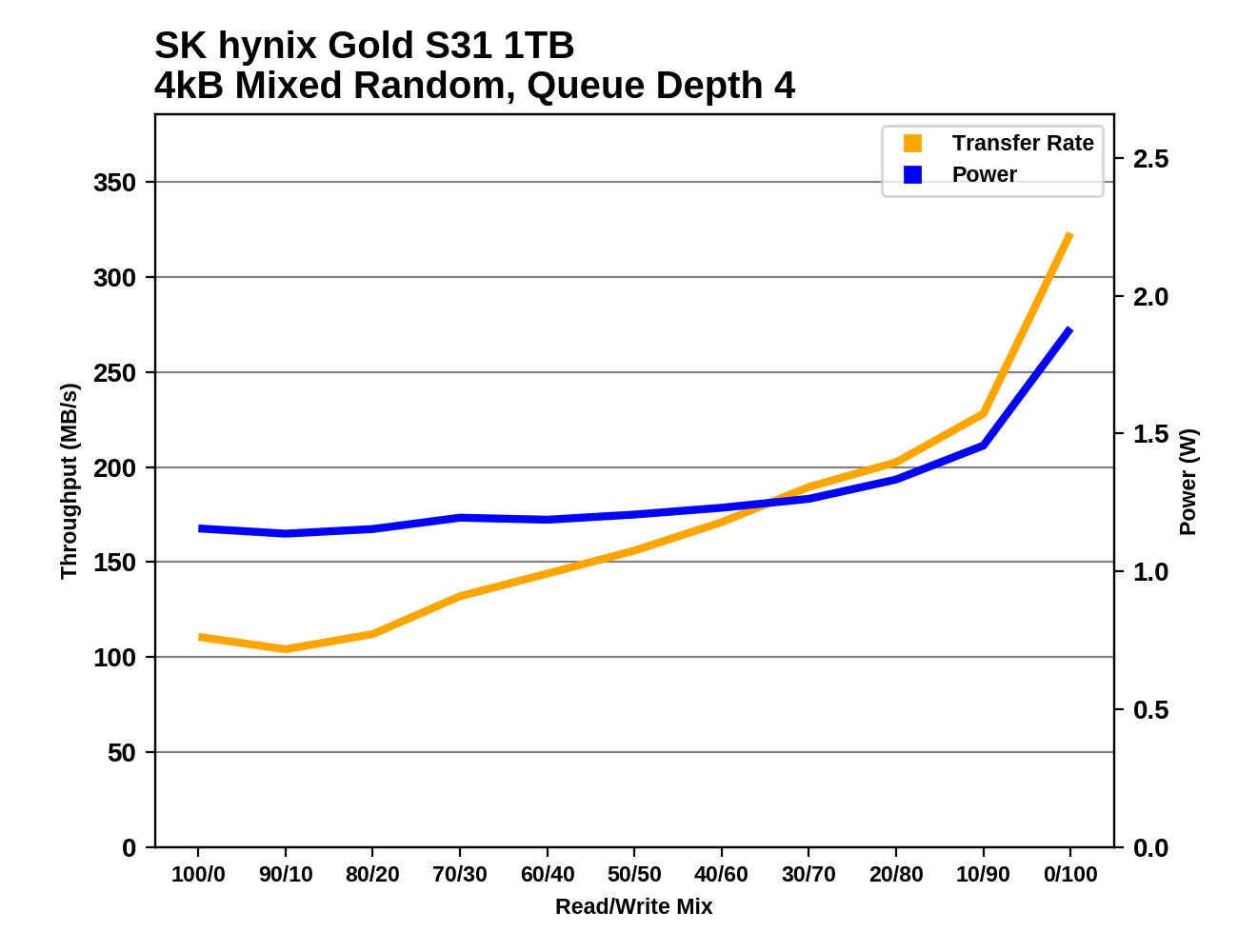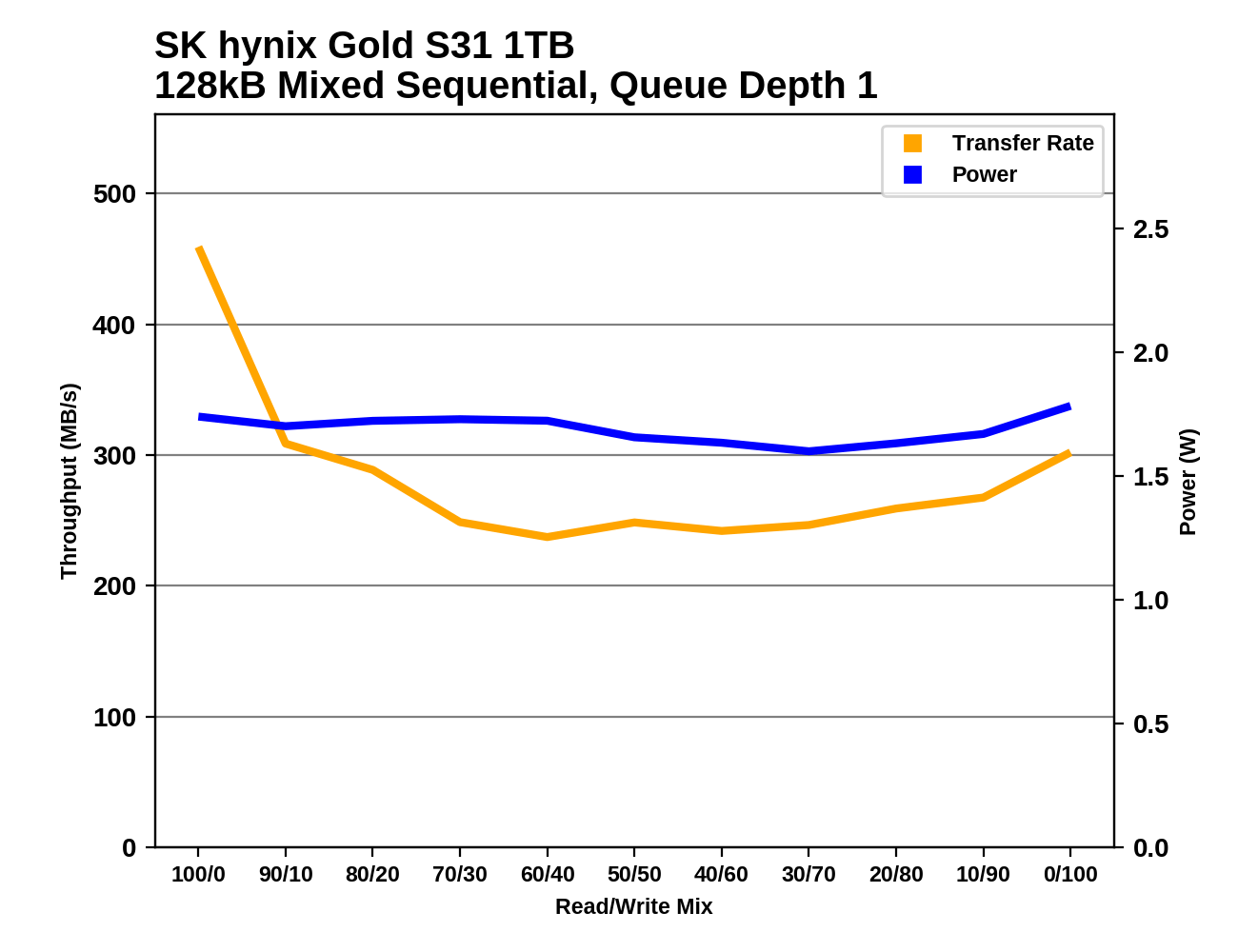The SK Hynix Gold S31 SATA SSD Review: Hynix 3D NAND Finally Shows Up
by Billy Tallis on November 13, 2019 12:00 PM ESTMixed Random Performance
Our test of mixed random reads and writes covers mixes varying from pure reads to pure writes at 10% increments. Each mix is tested for up to 1 minute or 32GB of data transferred. The test is conducted with a queue depth of 4, and is limited to a 64GB span of the drive. In between each mix, the drive is given idle time of up to one minute so that the overall duty cycle is 50%.

All three capacities of the SK Hynix Gold S31 perform fairly well on the mixed random IO test. The 1TB and 500GB models rank just behind their fastest competitors of like capacity, and the 250GB model performs on par with several drives of significantly higher capacity.
 |
|||||||||
| Power Efficiency in MB/s/W | Average Power in W | ||||||||
The three capacities again earn excellent power efficiency scores, second only to Samsung's 860 series drives. In absolute terms, the three are each averaging less power draw than any of the DRAM-equipped drives.
 |
|||||||||
Performance for the S31 on the mixed random IO test increases quickly as the proportion of writes in the workload is increased. As is typical, the test ends with a spike in performance as the workload shifts to 100% cacheable random writes. The 250GB model starts to fall behind after writes account for more than 20% of the workload, and it doesn't really catch up even at the end of the test.
Mixed Sequential Performance
Our test of mixed sequential reads and writes differs from the mixed random I/O test by performing 128kB sequential accesses rather than 4kB accesses at random locations, and the sequential test is conducted at queue depth 1. The range of mixes tested is the same, and the timing and limits on data transfers are also the same as above.

In stark contrast to the good overall performance on the mixed random IO test, the SK Hynix Gold S31 drives are all in the bottom performance tier for the mixed sequential workload test. The 1TB model is basically tied with a DRAMless SSD, and the smaller two are even slower though they outperform the DRAMless drive of similar capacity.
 |
|||||||||
| Power Efficiency in MB/s/W | Average Power in W | ||||||||
Even though performance on the mixed sequential IO test was clearly on the low side, the drives earn power efficiency scores that are only slightly below par. Their power consumption in absolute terms is still a bit lower than most of the competition.
 |
|||||||||
All three capacities of the S31 start out with decent performance with the pure-read workload phase of this test, but performance drops off quickly. The 1TB model spends most of the test hovering around 250MB/s and the 500GB model is a bit slower than that. The 250GB model takes until the 30/70% read/write mix for performance to level out at well under 200 MB/s.










22 Comments
View All Comments
MenhirMike - Wednesday, November 13, 2019 - link
We're not going to get under 10c/GB anytime soon, will we? SATA SSDs seem to be stagnant - performance is OK, power consumtion is OK, price is $100 for 1TB, endurance is the usual 0.3 WPD - and yet there are constantly new products with different components and basically the same performance/power/price.Is there a limitation that currently causes stagnation? (I know that SATA is inherently limited in performance, but price shouldn't be stagnant if the main need in that sector is more capacity for less money, with performance/power/endurance being the same)
FunBunny2 - Wednesday, November 13, 2019 - link
"price shouldn't be stagnant if the main need in that sector is more capacity for less money"all of these companies face the Tyranny of Fixed Cost, i.e. the BoM is almost all amortization of the plant and equipment to make the various bits and pieces. sand, some chemicals, and a watchman or two to hover over the machines amount to the variable cost. in such a situation, the only way to lower *average cost* (and shut up the bean counters) is to ship more product and thus spread the fixed cost a tad thinner. lots more product. but that, in turn, is strictly limited by user demand. they're caught between a rock and a hard place. they end up viewing the situation as zero-sum game; one can win only if the other(s) lose when there's little to no global (in every sense of the word) growth. welcome to Earthly Stagnation.
dromoxen - Thursday, November 14, 2019 - link
Having Dr ManHattan looking after your machines is a very expensive business , Rorschach is very unreliable too.eek2121 - Wednesday, November 13, 2019 - link
Except prices have been falling. You just don't realize it because it happens over time.These drives are as cheap as Samsung's QLC drives, without the disadvantages.
Slash3 - Wednesday, November 13, 2019 - link
SSD prices have been basically flat since October/November 2018. Check the price tracking for a 500GB/1TB MX500 or 860 Evo and there have been a few variations but nothing substantial or permanent.I'd love to pick up more large capacity solid state to replace some of my HDDs, but I bought two 2TB SSDs over a year ago and they're actually a few dollars *more* expensive now.
At this point, it may actually be cheaper to build a large NAS using MicroSD cards...
eek2121 - Wednesday, November 13, 2019 - link
I paid the same amount for my 2 TB 970 evo as I did my 1 TB 960 evo 2.5-3 years ago. Also, don't track specific drivers, look at charts. NAND is coming down. It just takes time.Slash3 - Wednesday, November 13, 2019 - link
/s implied with respect to the MicroSD card NAS, if it weren't obvious.Although that would be fun to build.
nandnandnand - Wednesday, November 13, 2019 - link
Sale prices are hitting 8c/GB. Don't pay 10c/GB if you live in America. As the average drive capacity goes up, the prices will continue to go down.Thankfully, 100 GB and larger games are a thing, so that should create some demand.
deil - Thursday, November 14, 2019 - link
we might PLC coming soon, so we might see some 1 TB/1.5 TB/2TB/3TB sata's soon and as they are 20% bigger after amortization wears off, almost 20% cheaper it will become.main focus will go to PCIE4.0 now though. so I would say next December expect 2 or 3 products with same nand. 120GB/240 will not go lower than its is now.
deil - Thursday, November 14, 2019 - link
in there on the article. We already did on 1 TB ones. and PLC will go even lower.ADATA SU800 $34.99
(14¢/GB) $57.99
(11¢/GB) $91.99
(9¢/GB) $209.99
(10¢/GB)